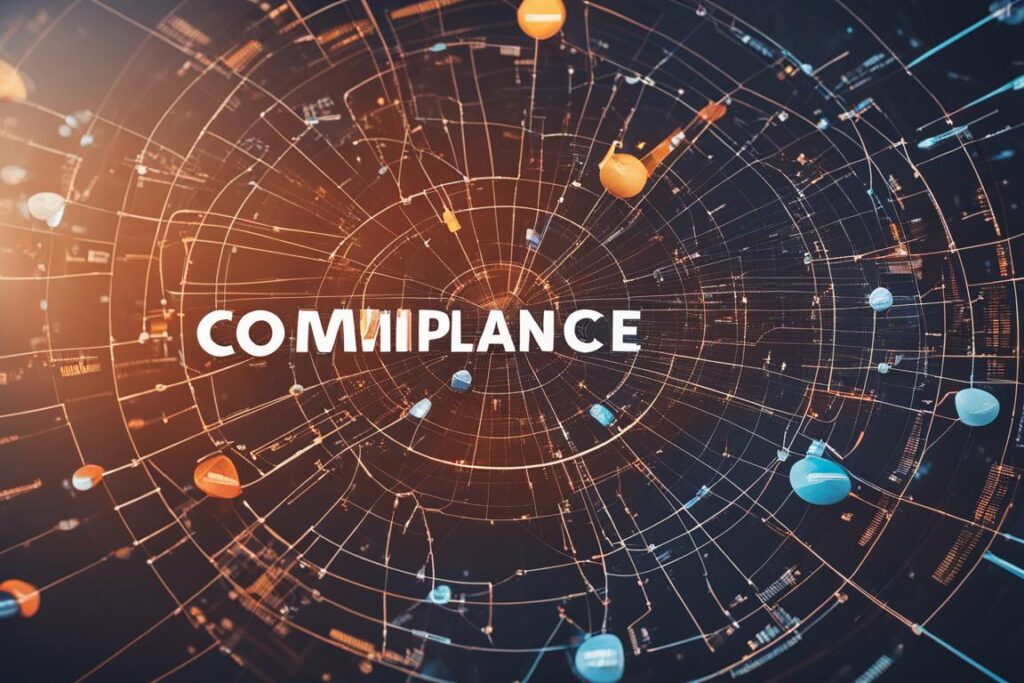Compliance management is essential for businesses as it ensures adherence to legal, ethical, professional, and contractual standards. Non-compliance can lead to severe penalties, operational downtime, and reputation damage. Compliance Management Systems (CMS) play a vital role in streamlining operations, controlling risks, and ensuring compliance. This guide will explore the key aspects of compliance management systems and their benefits.
Key Takeaways:
- Compliance management systems are crucial for businesses to ensure adherence to standards and avoid penalties.
- Non-compliance can result in operational downtime and damage to the company’s reputation.
- A Compliance Management System (CMS) helps streamline operations, control risks, and ensure compliance.
- By implementing a CMS, businesses can prioritize customer interests, meet regulatory requirements, and enhance cyber resilience.
- Adopting a CMS offers benefits such as efficiency, scalability, risk mitigation, improved reporting, and fostering a culture of compliance.
What is Compliance Management?
Compliance management is the process of ensuring that businesses and employees adhere to the legal requirements and ethical standards set by the industry. It encompasses a commitment to legality and ethics, aiming to build trust among stakeholders and maintain a strong reputation. By implementing effective compliance management practices, companies can mitigate operational risks and avoid severe repercussions such as fines, penalties, and operational downtime. Embracing compliance management is fundamental for the viability and longevity of a company.
“Compliance management is not just about following the rules; it is about instilling a culture of commitment to legality and ethics throughout the organization.”
Why is Compliance Management Crucial to Businesses Today?
Compliance management is an essential aspect for businesses today as it reinforces the prioritization of customer interests and fosters trust in the marketplace. By adhering to regulatory requirements, businesses demonstrate their commitment to maintaining ethical standards and ensure that their products and services meet the necessary compliance standards.
One of the key benefits of compliance management is its role in mitigating the impact of cyberattacks. By implementing robust compliance measures, businesses can enhance their cyber resilience and protect both their own and their customers’ sensitive information. This not only safeguards their reputation but also builds trust among stakeholders.
Compliance management is not only about meeting regulatory obligations but also about going beyond that to create an environment that prioritizes customer interests. It helps businesses stay on the right path by establishing clear guidelines and processes, ensuring that customers’ needs and expectations are met effectively.
Overall, compliance management plays a critical role in establishing a culture of accountability and transparency within businesses. By implementing effective compliance management systems, businesses can instill confidence in their customers, strengthen their reputation, and navigate the complex regulatory landscape with ease.
“Compliance management is not just about ticking boxes; it is about building strong relationships with customers and stakeholders based on trust and reliability.”
Key Takeaways:
- Compliance management demonstrates the prioritization of customer interests and fosters trust.
- Meeting regulatory requirements enhances cyber resilience and protects against cyberattacks.
- Compliance management helps businesses stay on the right path and prioritize customer interests.
- Effective compliance management systems create a culture of accountability and transparency.
What is a Compliance Management System (CMS)?
A Compliance Management System (CMS) is an integrated system that encompasses various components, such as documents, processes, tools, and internal controls. It functions to help organizations understand and meet their compliance responsibilities effectively.
By integrating compliance requirements into business processes, a CMS ensures that organizational activities align with the necessary legal, ethical, and professional standards. This integration also facilitates the creation of processes and workflows that streamline compliance-related tasks and responsibilities.
One of the key benefits of a CMS is that it enhances employee awareness and understanding of their compliance responsibilities. Through comprehensive documentation, training programs, and communication channels, employees gain greater clarity on the compliance expectations placed upon them.
Furthermore, a CMS enables organizations to review their operations systematically for compliance verification and corrective actions. This allows for proactive identification and mitigation of compliance risks, helping to prevent violations before they occur.
An effective CMS helps organizations achieve operational excellence by fostering a culture of compliance and embedding compliance into their everyday operations. By implementing a CMS, organizations can ensure that their compliance responsibilities are managed holistically, minimizing the risk of legal, ethical, and operational issues.
Key Features of a Compliance Management System
| Component |
Description |
| Documents |
Comprehensive documentation of compliance policies, procedures, and guidelines. |
| Processes |
Structured workflows and processes that incorporate compliance requirements into everyday activities. |
| Tools |
Software applications, platforms, and tools designed to facilitate compliance management and monitoring. |
| Internal Controls |
Monitoring and oversight mechanisms to ensure compliance across the organization. |
| Compliance Responsibilities |
Clear assignment and communication of compliance responsibilities to relevant stakeholders. |
The Role of Different Stakeholders in Compliance Management
Stakeholders play a crucial role in the effective implementation of a Compliance Management System (CMS). A well-structured CMS involves the collaboration and oversight of key stakeholders, including the board of directors and management.
The board of directors holds the responsibility of establishing the compliance vision and providing strategic guidance. They appoint a dedicated compliance officer who acts as the driving force behind the CMS. The compliance officer ensures that compliance programs are developed, implemented, and maintained in line with organizational goals and regulatory requirements.
The management team is responsible for providing steady oversight and support to the compliance officer. They work in tandem to cascade compliance expectations throughout the organization, driving a culture of compliance at every level. Management’s active involvement ensures that compliance is an integral part of daily operations and decision-making.
The compliance program serves as the central hub of the CMS. It encompasses policies, procedures, and controls designed to mitigate risks and ensure adherence to internal policies and regulatory requirements. The compliance program provides a framework for employees to understand their responsibilities and guides them in making compliant decisions.
Effective compliance programs involve continuous monitoring and assessment to ensure their effectiveness and identify areas of improvement.
Compliance audits play a critical role in assessing the effectiveness of the compliance program. These audits evaluate the organization’s compliance with internal policies and external regulations. They help identify any gaps or non-compliance issues, enabling timely corrective actions.
By involving stakeholders at various levels, organizations can establish a robust CMS that not only meets regulatory requirements but also fosters a culture of compliance. The collaborative efforts of the board, management, compliance officers, and audit teams ensure that compliance becomes an integral part of the organization’s DNA.
Key Takeaways:
- Stakeholders such as the board of directors and management play a vital role in compliance management.
- The board establishes the compliance vision, appoints a dedicated compliance officer, and provides strategic guidance.
- Management ensures steady oversight and cascades compliance expectations throughout the organization.
- The compliance program serves as the central hub, guiding employees in making compliant decisions.
- Compliance audits assess adherence to internal policies and regulatory requirements.

Benefits of Adopting a Compliance Management System
Adopting a Compliance Management System (CMS) offers numerous benefits for organizations. The implementation of a CMS enhances efficiency, providing a range of advantages such as reducing human error and freeing up time for strategic tasks.
The CMS also provides enhanced visibility into the compliance landscape, allowing businesses to identify potential risks and take proactive measures to mitigate them. Moreover, a CMS offers scalability, enabling organizations to adapt to business growth while ensuring continued compliance with regulations.
Another key benefit of a CMS is its adaptability to regulatory changes. With ever-evolving compliance requirements, businesses need a system that can keep up. A CMS provides the flexibility to update processes, policies, and controls in response to changing regulations, ensuring ongoing compliance.
A CMS also plays a critical role in risk mitigation. By implementing robust internal controls and processes, organizations can identify, assess, and manage risks effectively, reducing the likelihood of non-compliance and related consequences.
Furthermore, a CMS enables improved reporting by centralizing compliance data and automating reporting processes. This enhances the accuracy and timeliness of compliance reporting, providing stakeholders with valuable insights into the organization’s compliance performance.
Consistency is another key advantage of adopting a CMS. By standardizing compliance processes and procedures, businesses can ensure that compliance efforts are consistently applied across the organization, mitigating potential variations in adherence to regulations.
Beyond the tangible benefits, a CMS also fosters a culture of compliance within an organization. By establishing clear expectations, providing training, and holding employees accountable, businesses can create an environment where compliance is prioritized, encouraging ethical behavior and minimizing compliance risks.
Overall, adopting a compliance management system improves operational efficiency, visibility, scalability, adaptability, risk mitigation, reporting capabilities, consistency, and fosters a culture of compliance within an organization.
Benefits of Adopting a Compliance Management System:
- Improved efficiency by reducing human error and freeing up time for strategic tasks
- Enhanced visibility into the compliance landscape
- Scalability to adapt to business growth
- Adaptability to regulatory changes
- Risk mitigation through robust internal controls and processes
- Improved reporting by centralizing compliance data and automating reporting processes
- Increased consistency in compliance efforts across the organization
- Fostering a culture of compliance within the organization
“Adopting a compliance management system offers organizations a range of benefits, from improving efficiency to fostering a culture of compliance.”
The Essential Components of a Compliance Management System
A Compliance Management System (CMS) consists of three essential components that work together to ensure adherence to legal and regulatory requirements. These components include:
1. Leadership Oversight
In a Compliance Management System, leadership oversight is crucial for setting compliance expectations and demonstrating a commitment to ethical business practices. This involves the board of directors and senior management taking responsibility for compliance by appointing a designated compliance officer and ensuring regular monitoring and reporting of compliance activities. By providing clear guidance and support, leadership plays a key role in shaping a culture of compliance within the organization.
2. Compliance Program
The compliance program is the central hub of a Compliance Management System. It encompasses the policies, controls, and processes that guide employees in meeting regulatory requirements. This includes the development and implementation of compliance policies and procedures, as well as the establishment of internal controls that ensure adherence to these policies. A robust compliance program enables organizations to systematically manage risks and prevent non-compliance.
3. Compliance Audits
Compliance audits are an integral part of a Compliance Management System. These audits involve independent assessments of an organization’s compliance with internal policies and external regulations. By conducting regular audits, businesses can identify any gaps or weaknesses in their compliance programs and take corrective actions to address them. Compliance audits help organizations stay on track and continuously improve their compliance efforts.
By integrating these three components, a Compliance Management System establishes a strong foundation for regulatory compliance. It ensures that expectations are set from the top, policies and controls are in place, and regular assessments are conducted to verify compliance. This holistic approach enables organizations to mitigate risks, build trust with stakeholders, and maintain a culture of compliance.
Understanding Compliance Terminology
In the realm of compliance management, it is essential to familiarize oneself with key terminology to navigate the intricacies of this field effectively. By understanding the following terms, stakeholders can enhance their compliance efforts and ensure a robust and comprehensive compliance management system:
- Audit: Audits involve conducting comprehensive reviews of an organization’s operations, processes, and policies to assess compliance with internal guidelines and regulatory requirements. It helps identify areas of non-conformity and suggests improvements.
- Compliance Program: A compliance program refers to the set of policies, procedures, and controls put in place to ensure that an organization meets its regulatory obligations. It encompasses the systematic approach used to manage compliance and maintain adherence to legal and ethical standards.
- Policy: Policies are guidelines or rules established by organizations to align their operations with their objectives. Compliance policies provide a framework for employees to follow and ensure consistency in meeting legal, ethical, and operational requirements.
- Risk Analysis: Risk analysis involves identifying, assessing, and evaluating potential threats or vulnerabilities to an organization’s operations. It aids in proactively mitigating risks and implementing appropriate controls to safeguard against non-compliance and other risks that may adversely impact the organization.
- Non-Conformity: Non-conformity refers to a deviation from established compliance standards or non-compliance with regulations or internal policies. Identifying non-conformities is crucial as it highlights areas for improvement and prompts corrective actions to ensure compliance.
- Chief Compliance Officer (CCO): The Chief Compliance Officer (CCO) is a senior executive responsible for overseeing and managing an organization’s compliance efforts. The CCO plays a crucial role in developing and implementing effective compliance programs and ensuring adherence to regulatory requirements.
Quote:
“Understanding compliance terminology is essential for organizations to effectively manage their compliance efforts and uphold legal and ethical standards.”

Knowledge of compliance terminology provides individuals and organizations with a solid foundation to navigate the complex landscape of compliance management. It enables effective communication, aligns efforts, and facilitates the implementation of robust compliance strategies.
In the next section, we will explore one of the leading compliance management tools, StandardFusion, which can assist organizations in streamlining their compliance processes and enhancing overall compliance management effectiveness.
Exploring Compliance Management Tools: A Close Look at StandardFusion
Compliance management tools play a crucial role in ensuring effective compliance management for businesses. One such tool is StandardFusion, an all-purpose compliance management platform designed to streamline compliance processes and meet regulatory requirements efficiently.
StandardFusion stands out as a comprehensive solution that enables businesses to manage their compliance requirements effectively. It offers a user-friendly interface, robust features, and customizable workflows to cater to various industries and organizations of different sizes.
Additionally, StandardFusion provides industry-specific tools that address the unique compliance needs of specific sectors. This tailored approach ensures that businesses can align their compliance strategies with industry regulations and best practices, maximizing their compliance efforts.
Moreover, StandardFusion’s integration capabilities allow businesses to consolidate all their compliance-related data and processes into one centralized system. This integration not only enhances efficiency but also promotes transparency and visibility across the organization, ensuring that compliance responsibilities are properly assigned and tracked.
Furthermore, StandardFusion offers powerful GRC (Governance, Risk, and Compliance) software capabilities. This enables businesses to assess and manage risks, define control frameworks, conduct audits, and generate comprehensive reports. The GRC functionality empowers organizations to proactively identify and mitigate compliance risks, ensuring a proactive approach to compliance management.
Key features of StandardFusion:
- Customizable workflows to align with specific compliance requirements
- Document management capabilities to organize and control compliance-related documents
- Automated alerts and notifications to keep stakeholders informed
- Risk assessment and management tools to identify and mitigate compliance risks
- Compliance audit functionalities to assess adherence to policies and regulations
- Visualization and reporting tools for enhanced data analysis and decision-making
StandardFusion proves to be an indispensable tool for businesses seeking to establish a robust compliance management system. Its all-purpose compliance management platform, industry-specific tools, and GRC software capabilities enable organizations to effectively manage their compliance requirements, streamline processes, and enhance overall compliance management.
Best Practices for Implementing a Compliance Management System
Implementing a Compliance Management System (CMS) is a crucial step for businesses to ensure adherence to legal and ethical standards. To successfully implement a CMS, it is important to follow best practices that promote effective compliance management. These best practices include:
- Leadership Commitment: Strong leadership commitment is the foundation of an effective CMS. The leadership team should prioritize compliance and demonstrate their commitment to compliance management.
- Clear Policies and Procedures: Establishing clear policies and procedures is essential for employees to understand what is expected of them. These policies and procedures should align with regulatory requirements and industry standards.
- Employee Training: Training plays a critical role in ensuring employee awareness and adherence to compliance requirements. Regular training sessions should be conducted to educate employees about their compliance responsibilities.
- Regular Audits: Regular audits are essential to assess the effectiveness of the CMS and identify areas for improvement. These audits should be conducted by independent auditors to ensure impartiality and objectivity.
- Continuous Improvement: Compliance management is an ongoing process that requires continuous improvement. Feedback from audits and employee suggestions should be used to enhance the CMS and address any gaps or deficiencies.
“Implementing a Compliance Management System requires a comprehensive approach that involves strong leadership commitment, clear policies and procedures, employee training, regular audits, and continuous improvement. By following these best practices, organizations can establish a robust CMS that ensures regulatory compliance and mitigates risks.”
It is important to note that implementing a CMS is not a one-size-fits-all approach. Organizations should tailor their compliance management system to their specific industry, regulatory requirements, and organizational structure. This customization ensures that the CMS effectively addresses the unique compliance challenges faced by the organization.
By adopting best practices in implementing a compliance management system, organizations can establish a culture of compliance, mitigate risks, and protect their reputation in an increasingly complex regulatory landscape.
How Compliance Management Systems Optimize Business Operations
Compliance management systems play a crucial role in optimizing business operations by reducing risks, streamlining processes, and improving efficiency. These systems provide a systematic approach to manage compliance, enabling informed decision-making and enhancing overall operational effectiveness.
By implementing compliance management systems, organizations can proactively identify and address potential risks, minimizing the chance of non-compliance and its associated consequences. Streamlining processes through automated workflows and centralized data management allows for efficient compliance monitoring and reporting, saving time and resources.
Furthermore, compliance management systems enhance decision-making capabilities by providing real-time access to critical compliance information and actionable insights. This enables organizations to make informed decisions aligned with regulatory requirements and industry best practices.
“A compliance management system acts as the backbone of a business, seamlessly integrating compliance into everyday operations. It ensures that compliance is not seen as a roadblock but rather as a driver of success and sustainability.”
Improved efficiency is another significant benefit of compliance management systems. By automating manual processes, organizations can streamline their operations, eliminating duplication of efforts and reducing the risk of errors. This allows employees to focus on value-added tasks and strategic initiatives, driving productivity and overall business performance.
Overall, compliance management systems contribute to smoother business operations and better risk management by providing a centralized platform for managing regulatory compliance. By optimizing operations, reducing risks, and improving efficiency, organizations can achieve a higher level of compliance while fostering a culture of integrity and ethical conduct.

Benefits of Compliance Management Systems:
- Optimized operations through risk reduction and streamlined processes
- Enhanced decision-making based on real-time compliance information
- Improved efficiency by automating manual tasks and eliminating errors
- Fostered culture of compliance and integrity






